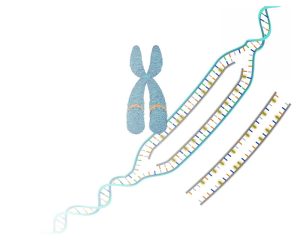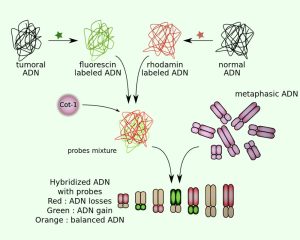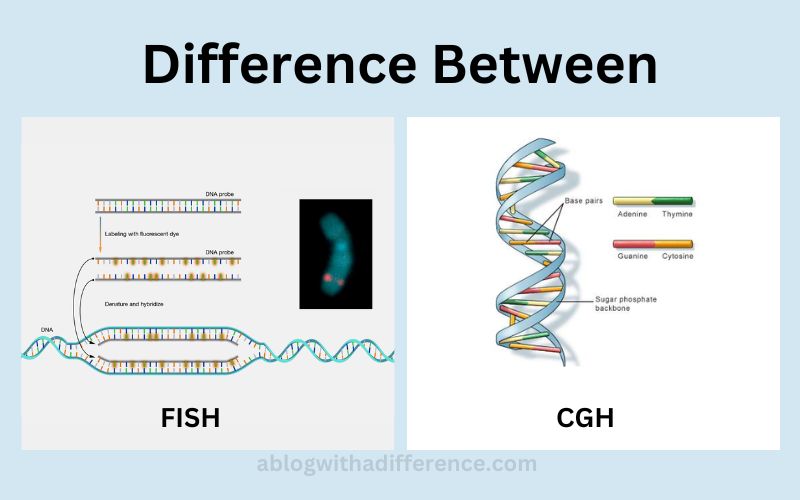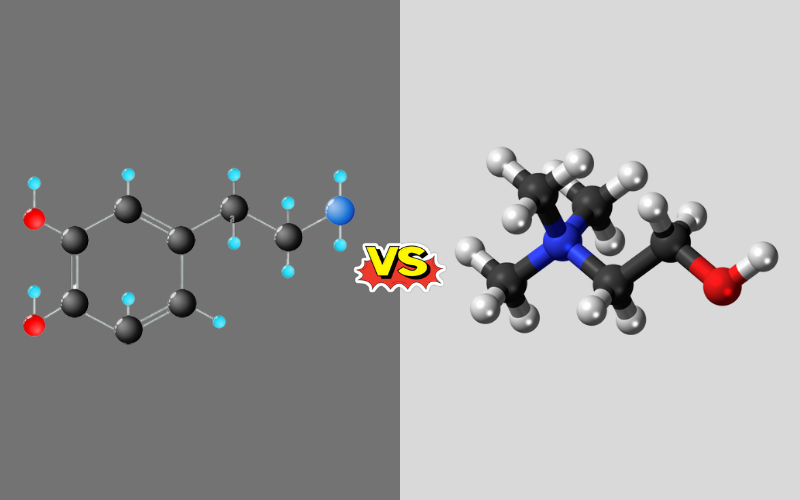Difference Between FISH and CGH
An Overview of FISH and CGH
FISH and CGH (Comparative Genomic Hybridization) are molecular cytogenetic procedures commonly employed for genetic analysis.
FISH utilizes fluorescently labeled DNA or RNA probes that bind with specific targets within chromosomes or nuclei to visualize sequences on specific genes or genomes; it allows mapping and visualization, making this technique ideal for the diagnosis of genetic anomalies such as abnormalities or changes to chromosomes as well as oncology screening or prenatal detection.
FISH offers high-resolution mapping of particular genetic regions while simultaneously revealing any structural changes or gene rearrangements that might exist within an organism’s genomes.
CGH involves hybridizing reference and testing DNA samples onto chromosome or microarray slides with DNA probes representing all regions of the genome, then comparing their fluorescence intensity ratio.
CGH provides a genome-wide investigation into copy number variation (CNVs). CGH has become popularly used for genomic profiling during cancer studies as well as CNV detection or preimplantation genetic diagnostics procedures.
Both techniques offer significant clinical value and are widely employed for genetic diagnosis as well as research to uncover genetic causes for disorders. FISH offers high-resolution analysis whereas CGH allows more thorough genomic examination. Together these techniques can combine to produce a comprehensive genetic examination.
Importance of genetic testing in medical diagnostics and research
Genetic tests play an integral part in medical diagnostics and research, providing numerous advantages that positively contribute to healthcare delivery.
Here are a few points which highlight their significance:
- Early Diagnosis of Disease: Genetic testing allows early identification and diagnosis, leading to more efficient treatments and improved outcomes for diseases that rely on genetic variations or mutations, making individuals susceptible. By recognizing genetic markers early diagnosis is possible and treatment is administered more promptly for improved results and health benefits.
- Genetic testing: Provides vital insight into an individual’s unique genetic makeup, enabling healthcare providers to tailor their care according to each person’s genetic profile and customize treatments or procedures Accordingly. This practice, known as personalization or precision medicine, increases efficacy while simultaneously decreasing adverse side effects by taking into account of all individual genetic features.
- Evaluating Risk and Preventive: Measures genetic testing can provide individuals with information to assist them in making informed decisions regarding their health and overall well-being. Based on this information, individuals can take measures such as changing lifestyle habits or attending regular screening tests that lower risks to reduce the risks for these genetic conditions or diseases. Taking such precautionary steps ensures a high degree of well-being.
- Prenatal Reproductive Health: Genetic testing plays an integral part in evaluating prenatal as well as reproductive health, providing early identification of genetic disorders or abnormalities within embryos or fetuses, helping inform decisions around family planning decisions as well as diagnosis of prenatal issues early and treating genetic conditions with treatment plans tailored for each pregnancy or gestation.
- Genetic Disease Management: Genetic testing can aid in the Identification and diagnosis of genetic diseases. It allows families and individuals to understand what may have led to them, providing appropriate treatment plans as well as counseling on genetics, planning families together as a unit, as well as support services that might provide assistance and counseling on genetic issues.
- Genetic Testing: Genetic tests provide an invaluable service, helping determine medication selection based on an individual’s genetic makeup and dosage needs. Pharmacogenomic tests predict how specific medicines will react for individuals; improving efficacy while simultaneously decreasing adverse side-effects or risks to individuals taking medication.
- Researchers and Scientific Advancements: Genetic testing provides invaluable assistance to medical researchers by providing crucial data that allows for studying how genetic elements impact diseases, population health and the development of drugs. Genetic testing facilitates the identification of novel genetic markers; provides greater insight into disease mechanisms; and aids the creation of innovative therapies.
- Improve Public Health: Genetic testing can aid public health efforts by helping identify those at risk of hereditary illnesses, providing specific screening programs, early interventions and strategies to combat disease prevention. It also aids research on population genetics monitoring diseases while simultaneously providing insight into genetic trends within specific groups.
Genetic testing plays an integral part of medical diagnostics and research, from early disease detection and risk evaluation, reproductive/prenatal health management and management of inherited conditions to technological advances and better results for public health. Genetic tests give people access to informed healthcare decisions while driving innovation within healthcare practices.
Fluorescence In Situ Hybridization (FISH)
FISH (Field In Situ Hybridization) is an in situ hybridization technique performed on sections or portions of tissue; this may also apply to cells. Probes used during FISH use Watson Crick complementary base pairing to generate hybrid DNA/RNA molecules which allow researchers to detect mutations or identify genes of interest in any given sample.

Additionally, this technique uses single and double-stranded DNA sequences as well as synthetic oligonucleotides prepared via nick translation to generate probes that match genes pertinent to.
This technique stands out by labeling probes with fluorescent dyes to make detection simpler and quicker. By binding with components on chromosomes that complement them, these probes become much simpler to spot.
FISH is an extremely sensitive and precise technique, making it one of the go-to tests for investigating and diagnosing both hematological malignancies as well as solid tumors. Unfortunately, however, its resolution remains low, necessitating detailed knowledge about each abnormality within an organism to develop probe sequences for FISH imaging.
FISH can be applied in various areas, with its primary application being molecular diagnostics of infections to detect that pathogens exist and identify them using molecular methods.
FISH has long been used in developmental biology, karyotyping and physical mapping of chromosomes for its benefits.
Comparative Genomic Hybridization (CGH)
Comparative genomic hybridization (CGH) is an advanced molecular cytogenetic technique that utilizes DNA sequence alterations in order to detect changes or modifications to genome DNA sequences. CGH uses powerful analysis capabilities on genes and chromosomes in order to assess any modifications or variations within them, providing more details than simply looking at DNA.
CGH experiments require isolating and fragmenting DNA extracted from both experimental samples as well as an identical reference sample, before labelling with two dyes (usually green and red) before any sample labelling takes place.
After mixing both samples together, hybridization begins in earnest. Once this step has finished, an examination of both samples to detect any changes to DNA such as gene duplications or deletions as well as differences between tested sample and one used as control will follow.

Another variant of CGH, known as array-based CGH or “aCGH,” has recently become available; this technique provides more sophisticated testing for sequence deletions or modifications across an entire experiment in one run. With its superior precision and ability to precisely pinpoint sequence or gene deletions over several experiments in just one experiment.
Difference Between FISH and CGH
FISH (Fluorescence In-Situ Hybridization) and CGH (Comparative Genomic Hybridization) are two cytogenetic molecular methods commonly used to analyze genetic information, but there are significant distinctions in their concepts as well as applications and capabilities between the two approaches.
Here are the primary distinctions among FISH CGH:
1. FISH Basic Principle:
- FISH: Fluorescent in Situ Hybridization (FISH) is an imaging technique which employs fluorescently labeled DNA or RNA probes which bind specifically to sequences within nuclei or chromosomes to allow visualisation and mapping of such sequences.
- CGH: Chromosomal Guthridge Hybridization (CGH) involves hybridizing fluorescently labeled test DNA as well as DNA from reference sources onto either chromosome slides or microarrays containing DNA probes that represent all genome regions; fluorescence intensity ratio analysis then allows one to detect gains or losses within specific chromosome regions.
2. Target:
- FISH: FISH can target specific genetic regions or sequences, such as genes or chromosomal regions of interest.
- CGH: CGH provides an in-depth examination of copy number variation (CNVs), and detects gains or losses across an individual’s entire genome. This test can detect gains/losses on every chromosome simultaneously.
3. Resolution:
- FISH: provides high-resolution maps of genetic regions that enable the detection of minute structural or gene rearrangement changes, which enable researchers to detect genetic rearrangements more readily than any other technology available today.
- CGH: Comparable to FISH, CGH provides an overall view of copy-number changes on a larger scale and thus lends itself well for discovering large scale genomic imbalances and copy-number variations (CNVs).
4. Applications:
- FISH: has many uses in medical diagnostics and oncology diagnostics as well as prenatal tests, from the detection of chromosomal anomalies to gene mapping cancer diagnostics oncology diagnosis as well as prenatal testing.
- CGH: CGH is used primarily to detect gains and losses of chromosomes as well as to detect CNVs; in doing genomic profiling research into cancer studies as well as preimplantation diagnostics (PGD) as well as research into developmental disorders.
5. Information Provided:
- FISH: FISH provides data pertaining to the presence or absence of specific genetic sequences within samples being studied, permitting easy detection and visualization of specific sequences within chromosomes.
- CGH: provides information about overall changes in copy number as well as regions with losses or gains of chromosomal material, providing a complete view of variations throughout the genome.
6. Data Analysis:
- FISH Analysis: FISH is typically employed to detect either the absence or presence of certain objects within samples being studied using fluorescent signals captured under a microscope.
- CGH: CGH generates large volumes of data that require computational analysis using specially created algorithms in order to detect changes and losses to chromosomes as well as evaluate results.
7. Balancing Rearrangement Detection:
- FISH: cannot detect balanced chromosomal rearrangements with no genetic material gained or lost, due to limitations inherent to FISH testing methods.
- CGH: Similar to FISH, CGH does not detect rearrangements of chromosomes that cannot be identified with FISH techniques such as karyotyping and targeted sequencing of genes; better ways of recognizing such rearrangements include karyotyping or targeted sequencing techniques for gene-targeted DNA samples.
The FISH analysis involves mapping and visualizing specific genetic sequences; CGH provides a more thorough examination of genome copy number variations across the genome.
FISH can detect small-scale anomalies more efficiently while CGH analyzes large-scale copy number fluctuations across the genome. Each technique offers distinct benefits depending on individual requirements for genetic research analysis.
Comparison Chart of CGH and FISH CGH
Here’s a chart that highlights the main differences between CGH and FISH:
| Aspect | FISH | CGH |
|---|---|---|
| Principle | Utilizes probes with fluorescent labels | The competitive hybridization of reference and test DNA samples |
| Target | Certain Genetic regions, or even sequences | Variations in Genome-wide Copy Numbers |
| Resolution | High | Less than FISH |
| Applications | Chromosomal aberrations, gene mapping, oncology, prenatal testing | Genomic profiling, CNV detection, cancer research, preimplantation genetic diagnosis |
| Information provided | The presence, absence or rearranging of particular objectives | Changes in overall copy numbers as well as the determination of chromosomal gains as well as losses |
| Data Analysis | Interpretation of light signals by the eye | Computational analysis with special algorithms |
| Balanced Rearrangement Detection | Do not detect the presence of balanced rearrangements. | It is impossible to detect the presence of balanced rearrangements. |
| Scope | Analysis with a specific focus | Genome-wide analysis |
This chart of comparison highlights the distinctions in FISH and CGH in relation to their fundamentals and objectives, resolutions applications, the information they provide as well as data analysis capabilities, the capability to identify balanced rearrangements and the range of analysis.
Knowing these differences can assist in determining the best technique for your particular needs of genetic analysis.
FISH and CGH share similar properties
Though FISH (Fluorescence In-Situ Hybridization) and CGH (Comparative Genomic Hybridization) differ substantially, they do share similarities as well.
Here are their commonalities:
- Introduction of Cytogenetics: Techniques FISH and CGH are molecular-cytogenetic procedures employed for genetic analysis to examine genetic variations or anomalies on chromosomes.
- DNA Probes: Both FISH and CGH methods use DNA probes marked with fluorescent molecules for visualizing purposes to locate genetic elements of significance or locations that require investigation. These DNA probes help facilitate precise genetic mapping.
- Genetic Anomaly Detection: The two methods below can be used to detect genetic anomalies and variations associated with disease such as deletions, duplications, translocations or amplifications that could contribute to genetic conditions like cancer or autism spectrum disorder.
- Clinical Applications: FISH and CGH have long been utilized as essential diagnostic medical research techniques, used for cancer detection, prenatal testing, genetic counseling services and to identify genetic disorders.
- Complementary Techniques: FISH and CGH can often be combined for more thorough analyses. FISH serves to validate any anomalies detected through CGH testing which provides more certain results.
- Research Tools: FISH and CGH are essential research tools in molecular genetics and genomics research, aiding researchers in their quest for understanding disease’s genetic causes by identifying disease-associated markers as well as investigating correlations between genetic variation and its consequences phenotypically.
Both FISH and CGH offer unique characteristics and functions; yet share similar applications when used for genetic analysis, detection of abnormalities in clinical applications, or research in molecular genetics.
Conclusion
FISH and CGH are two different molecular cytogenetic approaches with unique concepts, applications, and capabilities. FISH uses probes with fluorescent labels to show and map specific genetic sequences; CGH involves hybridizing reference DNA samples against test DNA samples for the identification of any gains/losses across the genome.
FISH can provide highly detailed analysis, from finding chromosomal abnormalities and gene mapping and localization to prenatal and oncology screening tests. Furthermore, its high-resolution maps offer high visibility into specific genetic regions while simultaneously revealing structural anomalies or gene rearrangements on a small scale.
CGH provides an efficient method for genome-wide examination of copy number variations that is invaluable in discovering large-scale genomic imbalances as well as CNVs. CGH can also be utilized as part of cancer research or preimplantation genetic diagnostic tests to help detect CNVs or perform cancer diagnostic profiling.


